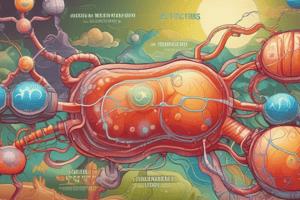Podcast
Questions and Answers
What is the primary role of ATP in metabolism?
What is the primary role of ATP in metabolism?
- To regulate enzyme activity
- To act as a structural component of cells
- To serve as the main energy carrier in cells (correct)
- To store proteins for growth
What type of metabolic pathway involves the breakdown of molecules to release energy?
What type of metabolic pathway involves the breakdown of molecules to release energy?
- Fermentation
- Photosynthesis
- Anabolism
- Catabolism (correct)
Which process generates the most ATP from glucose?
Which process generates the most ATP from glucose?
- Lactic acid metabolism
- Anaerobic respiration
- Aerobic respiration (correct)
- Fermentation
What occurs during the light-dependent reactions of photosynthesis?
What occurs during the light-dependent reactions of photosynthesis?
Which hormone plays a key role in lowering blood glucose levels?
Which hormone plays a key role in lowering blood glucose levels?
In which type of respiration are glucose molecules converted to lactic acid?
In which type of respiration are glucose molecules converted to lactic acid?
What regulates enzyme activity in metabolic reactions?
What regulates enzyme activity in metabolic reactions?
Which metabolic disorder is characterized by impaired glucose metabolism?
Which metabolic disorder is characterized by impaired glucose metabolism?
Flashcards are hidden until you start studying
Study Notes
Metabolism Overview
- Definition: Metabolism is the sum of all chemical reactions in an organism that maintain life. It involves converting food to energy, building cellular structures, and eliminating waste products.
- Types:
- Catabolism: Breakdown of molecules to release energy.
- Anabolism: Synthesis of molecules for growth and repair, using energy.
Energy Currency
- ATP (Adenosine Triphosphate):
- Primary energy carrier in cells.
- Produced during catabolic reactions and consumed during anabolic reactions.
Metabolic Pathways
- Enzyme Regulation: Enzymes facilitate metabolic reactions and are regulated by:
- Allosteric sites
- Feedback inhibition
- Pathway Types:
- Linear: Sequential series of reactions.
- Cyclic: Reactions that regenerate the starting molecule (e.g., Krebs cycle).
Cellular Respiration
- Types:
- Aerobic Respiration:
- Occurs in the presence of oxygen.
- Produces more ATP (up to 36-38 ATP molecules per glucose).
- Stages include Glycolysis, Krebs Cycle, and Electron Transport Chain.
- Anaerobic Respiration:
- Occurs without oxygen.
- Produces less ATP (2 ATP molecules per glucose).
- Includes processes like fermentation (e.g., lactic acid and alcoholic fermentation).
- Aerobic Respiration:
Photosynthesis
- Process: Conversion of light energy into chemical energy in plants.
- Stages:
- Light-dependent Reactions: Occur in thylakoid membranes; chlorophyll captures light to produce ATP and NADPH.
- Calvin Cycle: Occurs in the stroma; uses ATP and NADPH to convert CO2 into glucose.
Factors Affecting Metabolism
- Enzymatic Activity: Temperature, pH, and substrate concentration can influence enzyme activity.
- Hormonal Regulation: Hormones (e.g., insulin, glucagon) play a key role in regulating metabolic pathways.
- Nutritional Status: Availability of substrates (carbohydrates, fats, proteins) affects metabolic rates.
Metabolic Disorders
- Examples:
- Diabetes: Impaired glucose metabolism.
- Phenylketonuria (PKU): Inability to metabolize phenylalanine due to enzyme deficiency.
Importance of Metabolism
- Maintains homeostasis.
- Provides energy for physiological processes.
- Enables growth, repair, and reproduction of cells.
Metabolism Definition
- The sum of all chemical reactions that sustain life in an organism
- Includes processes like converting food into energy, building cells, and removing waste
Metabolism Types
- Catabolism: Breaking down molecules to release energy
- Anabolism: Building molecules for growth and repair using energy
Energy Currency
- ATP (Adenosine Triphosphate): The primary energy carrier in cells
- Produced during catabolic reactions and used during anabolic reactions
Metabolic Pathways
- Enzyme Regulation: Enzymes control the speed and type of metabolic reactions
- Allosteric sites: Molecules bind to an enzyme at a location other than the active site, affecting its function
- Feedback inhibition: The product of a pathway inhibits an enzyme earlier in the pathway, preventing overproduction
Pathway Types
- Linear: Reactions occur in a specific linear sequence
- Cyclic: Reactions regenerate the starting molecule, creating a cycle (e.g., the Krebs Cycle)
Cellular Respiration
- The process of breaking down glucose to release energy
- Aerobic Respiration: Requires oxygen and produces more ATP (up to 36-38 ATP per glucose)
- Glycolysis: Breaks down glucose into pyruvate
- Krebs Cycle: Oxidizes pyruvate to produce ATP and electron carriers
- Electron Transport Chain: Uses electron carriers to generate the majority of ATP
- Anaerobic Respiration: Occurs without oxygen and produces less ATP (2 ATP per glucose)
- Includes fermentation processes like lactic acid fermentation and alcoholic fermentation
Photosynthesis
- The process that plants use to convert light energy into chemical energy
- Light-dependent Reactions: Occur in the thylakoid membranes within chloroplasts
- Chlorophyll captures light energy to produce ATP and NADPH
- Calvin Cycle: Occurs in the stroma
- Uses ATP and NADPH to convert CO2 into glucose
Factors Affecting Metabolism
- Enzymatic Activity: Factors like temperature, pH, and substrate concentration can influence enzyme function
- Hormonal Regulation: Hormones like insulin and glucagon regulate the use and storage of energy
- Nutritional Status: The availability of substrates (carbohydrates, fats, proteins) affects metabolic rates
Metabolic Disorders
- Occur when there are problems with metabolism
- Diabetes: Impaired glucose metabolism
- Phenylketonuria (PKU): Inability to metabolize phenylalanine due to a missing enzyme
Importance of Metabolism
- Maintains homeostasis (stable internal environment)
- Provides energy for cell processes
- Enables cell growth, repair, and reproduction
Studying That Suits You
Use AI to generate personalized quizzes and flashcards to suit your learning preferences.




